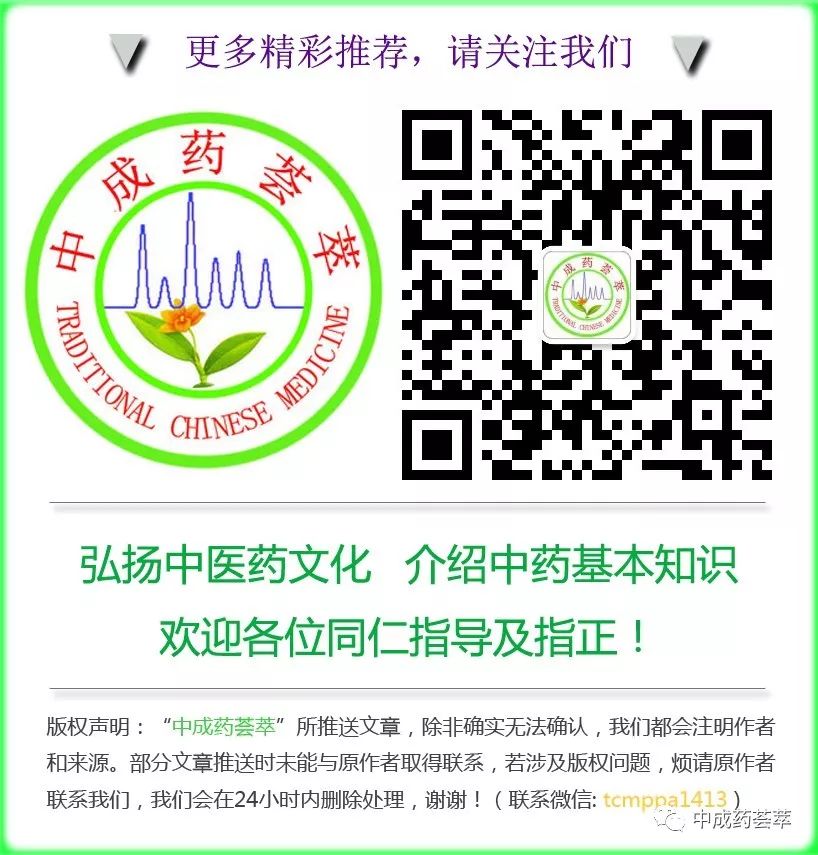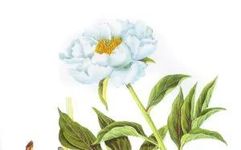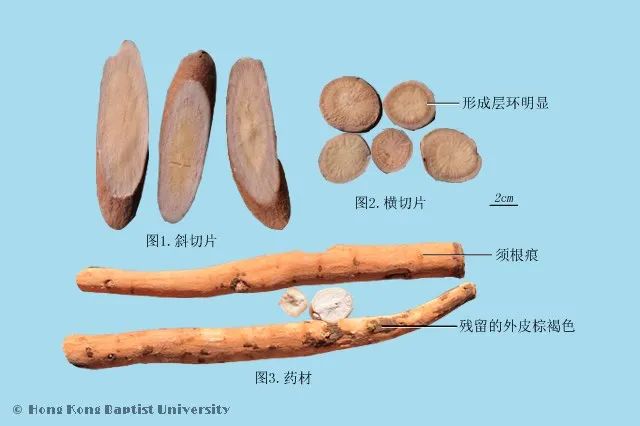
Bai Shao Identification Points☝
Premium Chinese Medicine | Bai Shao (White Peony)
Bai Shao (白芍) is the dried root of the plant Peony (Paeonia lactiflora Pall.) from the family Ranunculaceae. It is harvested in summer and autumn, cleaned, with the head, tail, and fine roots removed, boiled in water, and then the outer skin is removed or peeled before boiling again, and finally dried.【Properties and Channels】Bitter, sour, slightly cold. Enters the Liver and Spleen meridians.【Functions and Indications】Nourishes blood and regulates menstruation, astringes yin and stops sweating, softens the liver and alleviates pain, and pacifies liver yang. Used for blood deficiency with sallow complexion, irregular menstruation, spontaneous sweating, night sweats, flank pain, abdominal pain, limb cramps, headache, and dizziness.
Original Plant:
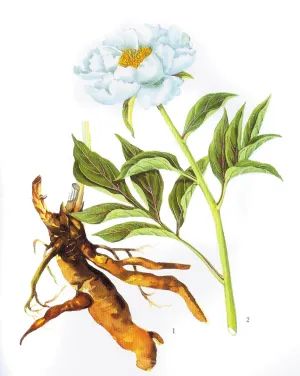
Herb/Decoction Pieces:
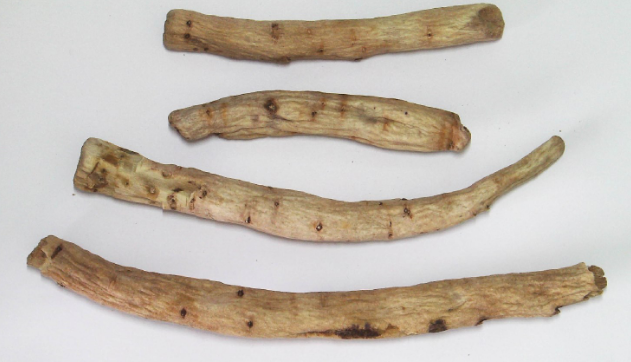
Specification Grades:
According to different origins, Bai Shao is classified into three specifications: “Hang Bai Shao”, “Bo Bai Shao”, and “Chuan Bai Shao”. Based on market circulation, the herbs may be graded into “selected goods” and “common goods”. The Bo Bai Shao is further divided into three grades: “first grade”, “second grade”, and “third grade” based on the diameter of the herb.
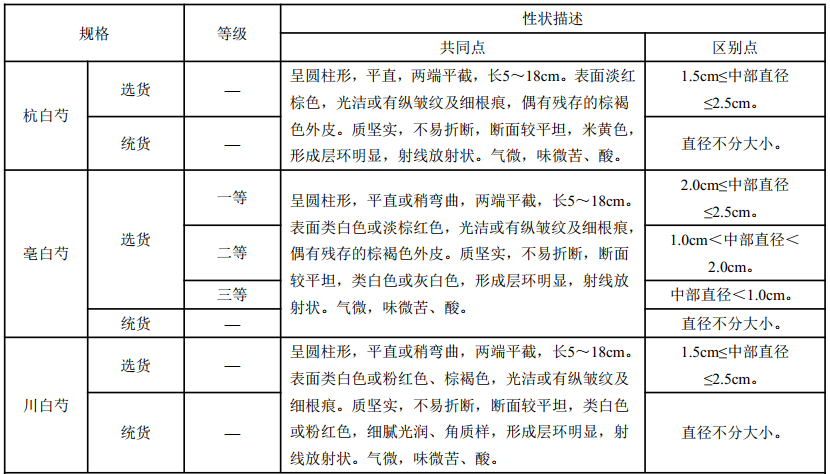
Note:
1. Bai Shao is mostly sold as decoction pieces in the herb market, with Bo Bai Shao being the most common.2. In recent years, the use of growth regulators and bulking agents has made it difficult to determine the quality of root herbs. Traditionally, “thick and long roots, firm texture” are considered high-quality Bai Shao, but root thickness does not fully reflect the quality of the herb, hence the classification of grades based on the diameter as per the Chinese Pharmacopoeia.
Herb Requirements:
No withered Shao;No bulbous heads;No corky skin;No hollowness;No immature growth;No insect damage;No mold.
Different Specification Grades of Herbs:
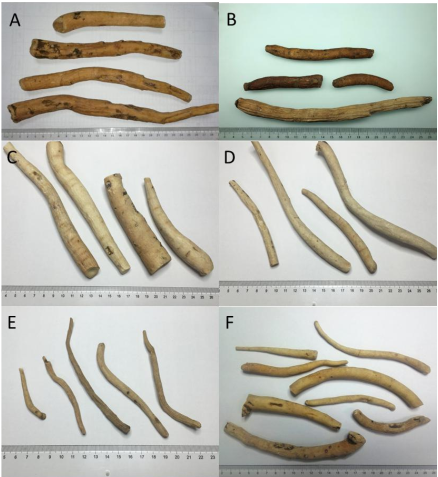
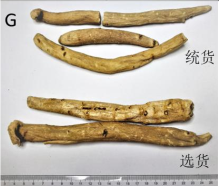
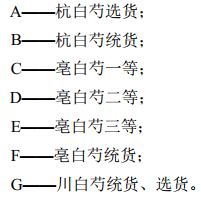
Overview:
During the Southern and Northern Dynasties, the “Compendium of Materia Medica” states: “The best comes from Bai Mountain, Jiang Mountain, and Mao Mountain.” In the Tang Dynasty, the “Dayhuazi Materia Medica” states: “Peony, Haiyan, Hang, and Yue are all good.” In the Song Dynasty, the “Illustrated Materia Medica” states: “It is found everywhere, but the Huainan variety is superior.” In the Song Dynasty, the “Extended Meaning of Materia Medica” states: “Peony, the whole root is used, and there are many varieties, the red flower and single leaf are preferred, those from the mountains are the best, while those with many flowers and leaves have weak roots.” In the Ming Dynasty, the “Essentials of Materia Medica” states: “Authentic: Zezhou, Bai Mountain, Jiang Mountain, Mao Mountain, Huainan, Haiyan, Hangyue.” In the Ming Dynasty, the “Materia Medica of the Mengquan” states: “The best comes from Huainan.” In the Qing Dynasty, the “Half Verse of the Materia Medica” states: “The best is from Guangling.” In the Qing Dynasty, the “Selected Medicinal Herbs of Yiben Tang” states: “The root is thick like a finger, hard when broken, pale red on the outside, pale white on the inside, bitter and astringent, with a fragrance is the best.” The 1977 edition of the “Chinese Pharmacopoeia” states: “The best is thick, firm, without white hearts or cracks.” The “Illustrated Authentic Medicinal Materials” states: “The best is thick and long, firm, without white hearts, withered, corky, moldy, or cracked.” The “Chinese Medicinal Sea” states: “The best is thick and long, straight, firm, with sufficient powder, and clean surface.” The “Traditional Experience Identification of Chinese Medicinal Materials” states: “The best is thick and long, firm, straight, smooth, and brightly colored.”
Bai Shao was not mentioned before the Wei and Jin Dynasties, and it was collectively referred to as Shao Yao with Chi Shao. The name Shao Yao first appeared in the “Book of Songs, Zheng Feng, Zhen Wei”: “Zhen and Wei, both are flowing… The man and woman, they jest with each other, gifting each other with Shao Yao.” It can be seen that in the Zhen Wei area, men and women exchanged Shao Yao to express their feelings.
The ancient Zheng State in the pre-Qin period was in the area of present-day Gao County and Changge County in Henan Province.
In the Qin and Han Dynasties, the “Shennong’s Classic of Materia Medica” states: “Peony grows in river valleys and hills.” According to later records, it is found north of the Yellow River, in Northeast, North China, and southern Shaanxi and Gansu.
In the Wei and Jin Dynasties, the “Record of Famous Physicians” states: “Peony grows in Zhongyue (present-day Dengfeng County, Henan) and hills, harvested in February and August.”
During the Southern and Northern Dynasties, the “Compendium of Materia Medica” states: “The best comes from Bai Mountain (present-day Jiangning County, Jiangsu), Jiang Mountain (present-day Purple Mountain, Nanjing), and Mao Mountain (present-day Jurong County, Jiangsu), white and long, while others are also available but mostly red, the red ones are of lesser quality…”
In the Tang Dynasty, the “Dayhuazi Materia Medica” states: “Peony, Haiyan, Hang, and Yue (present-day Haiyan, Hangzhou, and Shaoxing in Zhejiang Province) are all good.”
In the Song Dynasty, the “Illustrated Materia Medica” states: “It is found everywhere, but the Huainan variety is superior.”
In the Song Dynasty, the “Zhenglei Materia Medica” states: “According to the classic, Peony grows in hills and river valleys, but most of what is used today is cultivated by families.”
In the Ming Dynasty, the “Essentials of Materia Medica” states: “Authentic: Zezhou (present-day Jincheng City, Shanxi Province), Bai Mountain, Jiang Mountain, Mao Mountain, Huainan, Haiyan, Hangyue.”
In the Ming Dynasty, the “Materia Medica of the Mengquan” states: “The best comes from Huainan.”
In the Ming Dynasty, the “Half Verse of the Materia Medica” states: “It is found everywhere, cultivated by families. In the past, the Luoyang peony and Guangling peony were the best in the world. Now, the Guangling variety (present-day Yangzhou, Jiangsu) is considered superior.”
In the Qing Dynasty, the “Chongyuan Materia Medica” states: “Peony, originally from the Zhongyue mountain valley, is now found in Bai Mountain, Jiang Mountain, Mao Mountain, Huainan, Yangzhou, Jiang, Zhejiang, and Wusong, but many are cultivated in gardens.”
In the Republic of China, the “Identification of Medicinal Production” states: “Produced in Zhongjiang, Sichuan, the river herb is Chuan Shao, produced in Bozhou, Anhui is Bo Shao, produced in Hangzhou, Zhejiang is Hang Shao.”
References:
1. “Color Illustrated Guide to Medicinal Materials and Original Plants of the People’s Republic of China”
2. “Pharmacopoeia of the People’s Republic of China” 2020 Edition, Part One
3. Chinese Association of Traditional Chinese Medicine
